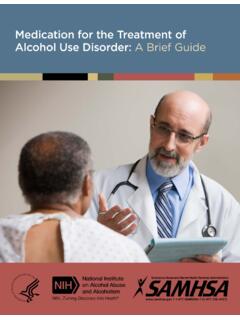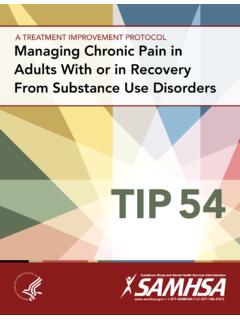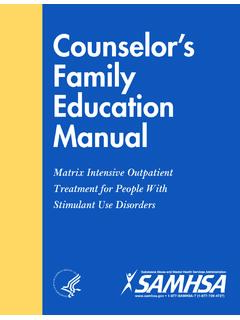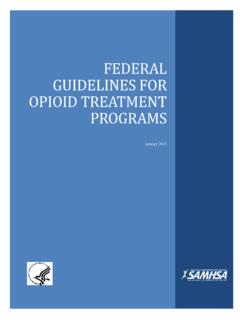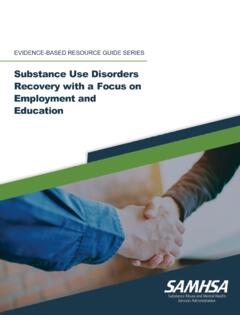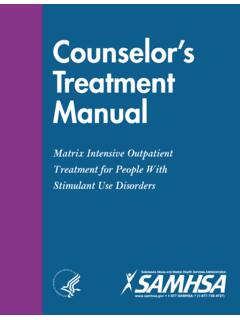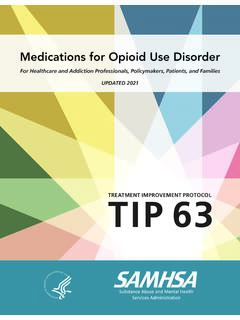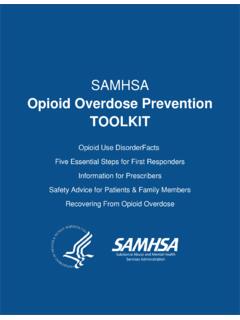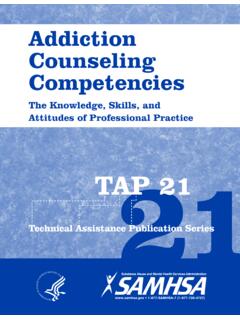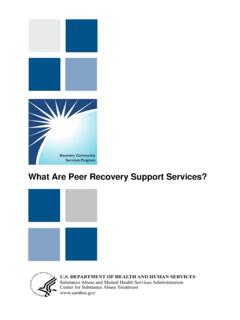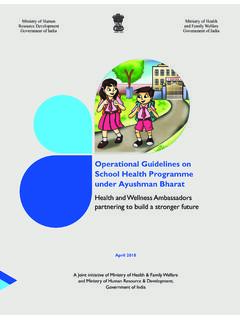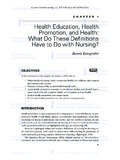Transcription of Promotion and Prevention in Mental Health
1 DEPARTMENT OF Health AND HUMAN SERVICESS ubstance Abuse and Mental Health Services AdministrationCenter for Mental Health and Prevention in Mental Health :Strengthening Parenting and Enhancing Child ResiliencePromotion and Prevention in Mental HealthPromotion and Prevention in Mental Health :Report to CongressRequested in Senate Report 109-103andConference Report 109-337 Submitted by Department of Health and Human ServicesSubstance Abuse and Mental Health Services AdministrationCenter for Mental Health Services Strengthening Parenting and Enhancing Child ResiliencePublic Domain NoticeAll material appearing in this report is in the public domain and may be reproduced or copied without permission from SAMHSA. Citation of the source is appreciated. However, this publication may not be reproduced or distributed for a fee without the specific, written authorization of the Office of Communications, SAMHSA, Access and Copies of Publication This publication may be accessed electronically through the following Internet World Wide Web connection: For additional free copies of this document, please call SAMHSA s Health Information Network (SHIN) at 1-800-SAMHSA-7, or 1-800-487-4889 (TDD).
2 Recommended CitationSubstance Abuse and Mental Health Services Administration, Center for Mental Health Services (2007). Promotion and Prevention In Mental Health : Strengthening Parenting and Enhancing Child Resilience, DHHS Publication Rockville, OfficeSAMHSA, Center for Mental Health Services 1 Choke Cherry Road, Room 6-1089 Rockville, MD 20857 DHHS Publication No. CMHS-SVP-0186 June 2007ivContentsExecutive I. Defining the Public Health Context of Children s Mental Health programs ..5 Section II. Review of Effective Parenting and Child Resilience programs ..17 Section III. Understanding the Costs and Benefits of Prevention programs ..29 Section IV. Best Opportunities for Implementing Evidence-Based Practices To Reach Families in Need ..37 Section V. Recommendations for Future Prevention Efforts ..45 Conclusion ..55 Acknowledgements ..57 References ..59vThe Senate Appropriations Subcommittee on Labor, Health and Human Services, and Education has charged the Center for Mental Health Services (CMHS), within the Substance Abuse and Mental Health Services Administration (SAMHSA), to review the effectiveness of programs that use a strength-based family approach to promoting Mental wellness and preventing Mental Health problems among at-risk children and youth.
3 The Committee further requested that CMHS identify opportunities and make recommendations related to the expanded use of such programs . Specifically, the Committee issued the following directive:The Committee believes that research-based Prevention and wellness Promotion efforts that strengthen parenting and enhance child resilience in the face of adversity can have a significant impact on the Mental Health of children and youth. While some programs that use such a strengths-based approach exist for families already in contact with the juvenile justice system or at immediate risk for dissolution, evidence suggests that they may be particularly effective for families that have one or more risk factors but are not yet in crisis and may not have had contact with child protective services or other government agencies. The Committee requests CMHS to provide it with a report by May 1, 2006, that reviews the effectiveness of such programs and the best opportunities to implement them so they reach families in need, and offers recommendations for future preventive efforts in this area.
4 (Senate Report 109 103)The purpose of this report is to respond to the requests made by the Committee. The report begins by describing the public Health context for the Promotion of Mental Health and the Prevention of Mental disorders in b It then describes opportunities for implementing evidence-based programs to reach families in need and summarizes the evidence base that shows that the programs do indeed strengthen the caretaking skills of parents and other caregivers and enhance child Next, it presents current knowledge about the economics of these programs , suggests how to reach families with interventions, and concludes with a In this document, the term Promotion is used in lieu of the phrase Promotion of Mental Health , and the term pre-vention is used in lieu of the phrase Prevention of Mental Health problems or disorders. b In this report, the word children applies to individuals ages birth to age 19. The terminology for the appropriate age range ( , infants, toddlers, or adolescents) is used whenever the discussion relates to a specific age group.
5 C An evidence-based program or practice is one that has been proven through well-designed research to demonstrate posi-tive outcomes for Summary1recommendations for further dissemination of these of all lifetime cases of diagnosable Mental illnesses begin by age 14, and three-fourth by age Focusing Promotion and Prevention efforts on children and their parents or other caregivers increases the likelihood that Mental Health problems in children will be addressed early, before they can evolve into full-blown Mental illnesses, including substance programs aimed at older age groups also provide benefits, but research suggests that greater and more long-term benefits accrue when programs begin early in the lives of children. Defining the Public Health Context of Children s Mental Health ProgramsPromotion and Prevention are key elements of a public Health approach to Mental Health . Rather than focusing on the treatment of individuals who already have an illness, the public Health approach is concerned with the Health of an entire population.
6 It includes traditional areas of medicine diagnosis, treatment, and the causes of an illness but it also focuses on disease surveillance, Health Promotion , disease Prevention , and access to and evaluation of The underlying premise of a public Health approach is that it is inherently better to promote Health and to prevent illness before an illness begins. d This report uses the term problems to describe Mental Health challenges experienced by children. According to the Institute of Medicine, disorder as defined in the American Psychiatric Association s Diagnostic and Statistical Manual of Mental Dis-orders (DSM-IV) refers to a clinically significant behavioral or psychological syndrome or pattern that occurs in an indi-vidual and that is associated with present distress ( , a painful symptom) or disability ( , impairment in one or more important areas of functioning) or with a significantly increased risk of suffering death, pain, disability, or an important loss of freedom (emphasis added) (American Psychiatric Association [2000], p.)
7 Xxxi). Use of the term problem acknowledges that not every child with a need for Mental Health care has such significant impairment that it qualifies as a disorder. Fundamental to the public Health approach is the issue of risk and protection. Research and practice have identified risk and protective factors that affect the vulnerability of children to Mental Health problems. Some of the risk factors, such as poverty and community violence, cannot be eliminated or ameliorated by a Mental Health program alone. However, many protective factors such as relationship skills, conflict management, and positive problem-solving can be taught to children, family members, teachers, and other caregivers. Also fundamental to the public Health approach is that Mental Health is everyone s concern. Responsibility for Promotion and Prevention programs is shared across multiple systems, including schools, primary Health care, Mental Health care, juvenile justice, child welfare, and substance abuse of Effective Parenting and Child Resilience ProgramsFamily-focused, evidence-based programs implemented with fidelity can have a profound, positive effect on parenting behavior and the developmental trajectories of children whose life course is threatened by multiple risk factors.
8 The knowledge base about programs that work is expanding and becoming more accessible to decision makers through Federal programs such as: The White House Helping America s Youth Initiative The Prevention Research Program at the National Institute of Mental Health (NIMH) and the NIMH-sponsored doctoral and postdoctoral training programs in Prevention Research and Children s Mental Health Services Research The 10 National Academic Centers of Excellence on Youth Violence, sponsored by the Centers for Disease Control and Prevention The Substance Abuse and Mental Health Services Administration s (SAMHSA s) National Registry of Evidence-Based programs and Practices. Understanding the Costs and Benefits of PreventionEconomic analyses of Promotion and Prevention programs are complex and costly. However, program developers are increasingly having the analyses conducted by independent organizations. An understanding of the costs and benefits of a program is extremely helpful to local implementers who are selecting a program for their community.
9 Many programs show very attractive Though small in number, long-term follow-up studies have shown that some programs continue to generate positive returns over a number of years as participants grow into healthy, well-functioning Opportunities for Implementing Evidence-Based Practices To Reach Parents and Other Caregivers in NeedParents and other caregivers are a child s first and foremost teachers. Promotion and Prevention programs that address issues of parents and other caregivers increase the potential of positive outcomes. Family members and caregivers should be equal partners, along with school and community leaders in selecting, implementing, evaluating, and sustaining programs . Parents and other caregivers are more likely to be involved if services are provided in easily accessible settings and if they are culturally and linguistically settings present a key opportunity to reach out with evidence-based programs to parents and other caregivers because the social and emotional skills taught by these programs usually have a positive impact on improving academic achievement.
10 Primary Health care also offers great potential to involve families in Mental Health Promotion and Prevention , and their support is extremely helpful when early intervention is indicated. Primary Health care physicians currently identify only a small percentage of children with behavior and emotional problems, but the percentage is likely to increase if the physicians respond to a key conclusion of a recent Institute of Medicine (IOM) report. As stated unconditionally by the IOM, We cannot improve our overall Health care system adequately unless we pay equal attention to addressing the issues surrounding Mental and substance abuse disorders. 4 Recommendations for Future Prevention EffortsMany evidence-based resilience-building Prevention programs exist, and more are being developed as the need for and the value of these programs becomes more apparent. The critical next step is for more communities to become aware of these programs and to engage a broad-based coalition in implementing them, even while researchers continue to expand the knowledge base.
